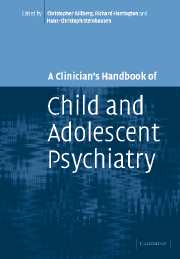Book contents
- Frontmatter
- Contents
- Preface
- List of contributors
- 1 Brain disorders
- 2 Substance use disorders
- 3 Schizophrenia and schizophrenia-like disorders
- 4 Affective disorders
- 5 Anxiety disorders
- 6 Obsessive-compulsive disorders
- 7 Adjustment disorders
- 8 Post-traumatic stress disorder
- 9 Functional somatic symptoms and somatoform disorders in children
- 10 Eating disorders: anorexia nervosa and bulimia nervosa
- 11 Sleep disorders
- 12 Personality disorders
- 13 Mental retardation/learning disability
- 14 Specific developmental disorders of speech and language
- 15 Reading and other learning disorders
- 16 Autism spectrum disorders
- 17 Hyperkinetic disorders
- 18 Conduct disorders
- 19 Elective mutism
- 20 Attachment and disorders of attachment
- 21 Tic disorders
- 22 Elimination disorders: enuresis and encopresis
- 23 Physical and sexual abuse
- 24 Gender identity disorders
- Index
- References
14 - Specific developmental disorders of speech and language
Published online by Cambridge University Press: 06 August 2009
- Frontmatter
- Contents
- Preface
- List of contributors
- 1 Brain disorders
- 2 Substance use disorders
- 3 Schizophrenia and schizophrenia-like disorders
- 4 Affective disorders
- 5 Anxiety disorders
- 6 Obsessive-compulsive disorders
- 7 Adjustment disorders
- 8 Post-traumatic stress disorder
- 9 Functional somatic symptoms and somatoform disorders in children
- 10 Eating disorders: anorexia nervosa and bulimia nervosa
- 11 Sleep disorders
- 12 Personality disorders
- 13 Mental retardation/learning disability
- 14 Specific developmental disorders of speech and language
- 15 Reading and other learning disorders
- 16 Autism spectrum disorders
- 17 Hyperkinetic disorders
- 18 Conduct disorders
- 19 Elective mutism
- 20 Attachment and disorders of attachment
- 21 Tic disorders
- 22 Elimination disorders: enuresis and encopresis
- 23 Physical and sexual abuse
- 24 Gender identity disorders
- Index
- References
Summary
Introduction
The communication skills of listening and speaking are basic to virtually every aspect of human life because they permit the sharing of feelings, thoughts, ideas and information with others. Most children acquire listening and speaking skills effortlessly in the course of development. A few children, however, experience significant problems in acquiring these key communication abilities, despite seemingly normal development in other areas. These children are considered to have specific developmental disorders of speech and language and are at risk for other associated learning, emotional and behavioural disorders.
The ICD-10 designates several types of specific developmental disorders of speech and language (see Table 14.1). A key distinction central to the typology is that between speech, the complex and rapid motor movements that translate ideas into spoken words, and language, the conventional code used to understand and express ideas. The ICD-10 explicitly recognizes one type of speech disorder, specific speech articulation disorder, and three types of language disorders, expressive language disorder, receptive language disorder and acquired aphasia with epilepsy (Landau–Kleffner). Other speech and language difficulties are classified as one of two remaining types: other or unspecified. In all types, the normal acquisition of speech and/or language skills is delayed or disrupted early in infancy or childhood, while other aspects of development proceed in a relatively normal fashion. Moreover, the speech or language difficulties are not attributable to obvious sensory, structural, cognitive or neurological problems.
- Type
- Chapter
- Information
- A Clinician's Handbook of Child and Adolescent Psychiatry , pp. 388 - 416Publisher: Cambridge University PressPrint publication year: 2006
References
- 1
- Cited by



